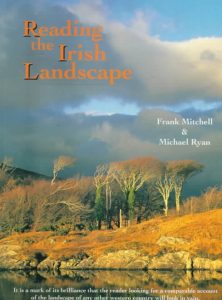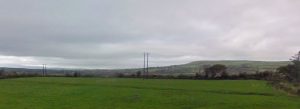
One of the hardest things for the mind to grasp is the sheer scale of the timespans that surround us. I recently came across something in Frank Mitchell’s classic Reading the Irish Landscape (Dublin, 1987, 2nd ed. 1997) that illustrates that scale very vividly. He is writing about chalk and its place in the geological make-up of Ireland. Chalk is white limestone formed from the compressed skeletal remains of single-celled sea-creatures just thousandths of an inch in diameter. Hundreds of millennia of warm shallow seas are needed to build up even a small deposit of chalk. But Mitchell points out that around 100 million years ago a layer of chalk more than 100 metres deep covered the whole of Ireland. Imagine that slow, invisible snowfall of tiny skeletons and then the sheer length of time required for it to produce and then compress a 100-metre-deep deposit.
And that layer of chalk has itself now vanished almost completely – outside the extreme north-east the only evidence it ever existed is a deep pit of chalk at Ballydeenlea near Farranfore in Kerry, apparently preserved when the limestone on which it was sitting collapsed.

Otherwise every trace of the layer has gone. How much weathering, over how long, was needed to scour away such massive quantities of chalk?
For any geologist this all happened yesterday. There are changes in the rocks around us that record events 500 million years ago, a billion years ago and more. The oldest surviving civilisation on the planet is in China, whose culture can trace itself over at least 3,000 years. Some Chinese families have traditions that follow their ancestors over more than 60 generations.
To our shallow Western sense of the past, this is extraordinary. But it is not long enough for even the lightest fall of chalk.
John,
Great,very interesting.
Elaine
I did not know about the chalk deposit in Ireland, but I have often thought that humans (who often think themselves very important) are really not more than specs of dust. It is very difficult to think of time on that scale, isn’t it.
Thanks for an interesting column. I enjoy reading your thoughts about different subjects. I enjoyed meeting you in person, in Minneapolis, this summer at the Celtic Roots conference. I often think about your remark that we Irish Catholics just throw ourselves at a project or mission or whatever, logic be damned. As I often do that very thing, it was an interesting comment to hear. I can perhaps now blame it on my roots. I hope your day is great. Christy
When driving through cut sections (where the road was literally cut through sections of rock) of roadways here in North America I often think someone should put a few year markers on the striations in the rocks that envelope each side of a roadway. This way we could be reminded how little a line we will leave when we are gone. Just to put it all into perspective for all of us – a microscopic black line in a cliff of lines.
I always enjoy reading what you write as it is so interesting and educational. Keep up the good work. There is still so much history for us to learn.
I recently returned from a week in North Antrim where geology–and limestone–are on full display. That part of Ireland–and nearby Scotland– offer a fascinating study on how geology shapes culture. Several of my ancestral lines are from there. Thanks for this post–I have requested the book from the library. I always learn so much from your posts and books.
What a vision John…..thanks for your thoughts .
With Aboriginal Australians now authenticated to 40,000 years, and the oldest surviving culture on the planet, the timespans and geological uncoverings for us here in the oldest continent on earth are even more mind-boggling, and difficult to comprehend. Thankfully, your guides to places and historical times in Ireland make life easier when tracking things in your neck of the woods. Your work is much appreciated by the diaspora.
I found the article on chalk quite interesting. A few years ago my brother was operating an earthmoving machine at Saggart Co. Dublin.
I visited the site and found that a layer of turf lay under about four feet of earth. We recovered pieces of a tree from that level.
After digging further down through more earth and clay, we found a layer of chalk veginning about ten feet down. Pure white hard chalk.